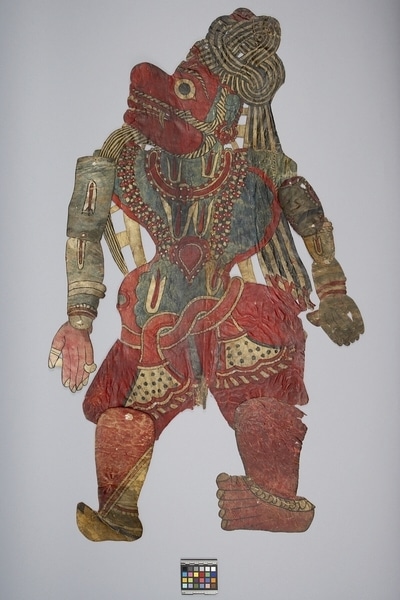Shadow Puppet Item Number: Ef227 a-b from the MOA: University of British Columbia

Description
Leather cut-out shadow puppet representing Surgriva, the Monkey King. The figure is a monkey with red skin dressed in military costume with a twisted black and white turban, thick red, black, and natural brown coloured necklaces, and chest ornaments from which a large red heart shape is suspended. Has sharp fangs, a striped moustache, and beard. Four moveable limbs. Feet are not matching. One foot (part b) is detached, has five toes, and an anklet around its red skin. Colours also include green.
History Of Use
Tholu bommalata translates as 'the dance of leather puppets.' Puppetry, particularly shadow puppets, is an ancient dramatic form in India mentioned in the Buddhist Jataka Tales of the 3rd century B.C.E. Nowadays modern forms of entertainment, such as the Hindi film industry, have rendered them extinct except for some rural areas in the states of Orissa, Kerala, Andhra Pradesh, and Tamil Nadu. The Andhra Pradesh/Karnataka shadow puppet tradition, compared to the few remaining troupes, are the most extensive and dramatic. Probably originally Maharashtran and maintained by dynasties, such as the Vijaynagars of the 13th and 14th centuries, it now survives as presented by Marathi-speaking puppeteers, commonly called Raoji. These are the largest in size of the Indian shadow puppets.
Iconographic Meaning
Represents Sugriva, son of the sun and younger brother of Vali, slain by Rama while attempting to recover Sugriva's wife from Vali. Sugriva is the monkey king, master of the devoted Hanuman. The colour red is associated with this monkey form. He wears Maratha turban, reminiscent of the origins of Andhra puppetry. As a devotee of Vishnu, he has two vertical marks on chest, forehead, and arms.
Item History
- Made in Andhra Pradesh, India between 1880 and 1930
- Collected during 1976
- Owned by Stephen Inglis before December 2, 1977
- Received from Museum of Anthropology Donations Fund (Funding source) and Stephen Inglis (Seller) on December 2, 1977
What
Who
- Culture
- South India
- Previous Owner
- Stephen Inglis
- Received from
- Museum of Anthropology Donations Fund (Funding source) and Stephen Inglis (Seller)
Where
- Holding Institution
- MOA: University of British Columbia
- Made in
- Andhra Pradesh, India
When
- Creation Date
- between 1880 and 1930
- Collection Date
- during 1976
- Ownership Date
- before December 2, 1977
- Acquisition Date
- on December 2, 1977
Other
- Condition
- poor
- Accession Number
- 0411/0234 a-b